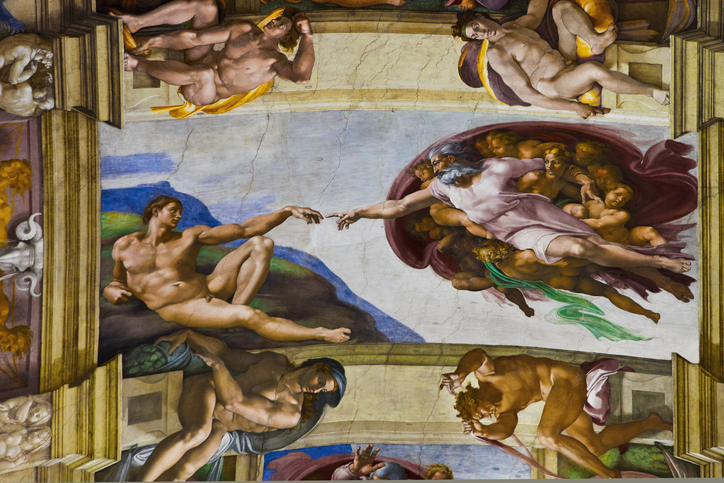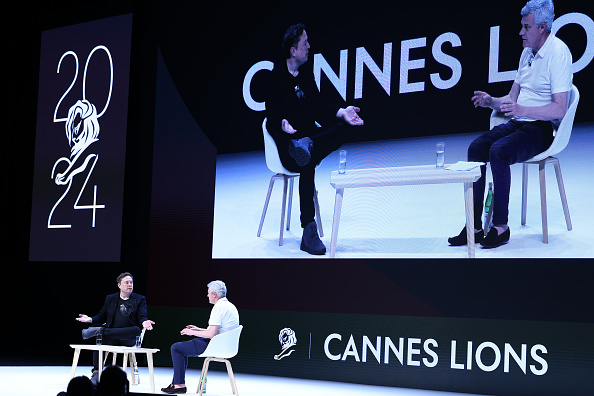Is That a Secret Michelangelo Selfie at the Sistine Chapel?
A new theory suggests that the Renaissance master modelled his iconic image of God after himself
Michelangelo may have secretly painted himself onto the ceiling of the Vatican’s Sistine Chapel, portraying himself as God with arm outstretched to spark life in a lounging Adam.
The theory, if true, underscores Michelangelo’s outsize ego, or at least his cheeky sense of humour. The hunch, which is gaining traction among Italian Renaissance scholars, also places the artist’s self-portrait squarely at the center of one of the most famous images in Western art.
“Michelangelo saw himself as the Messiah of art, so it makes sense,” said Adriano Marinazzo, a curator of special projects at Virginia’s Muscarelle Museum of Art at The College of William & Mary who published the theory last December in the peer-reviewed Italian art journal Critica d’Arte.
Although the artist painted more than 300 biblical characters across 5,000 square feet of ceiling, the central action in Michelangelo’s masterpiece is “The Creation of Adam.” The section shows an elderly, bearded God twisting beneath a floating cloak so that the fingertips on his right hand nearly reach a lackadaisical Adam, who represents mankind.
Mr. Marinazzo, who has a record of Michelangelo-related discoveries, said he made the connection after studying a sheet of paper containing a sonnet Michelangelo wrote to his friend Giovanni da Pistoia between 1509 and 1511. In the sonnet, Michelangelo complains about the physical toll the job has taken on his health.
“My brush, above me all the time, dribbles the paint so my face makes a fine floor for droppings,” the artist wrote.
In the sonnet’s margins, the artist also drew a man, presumably himself, standing with legs slightly crossed while painting a ghoulish face on the ceiling with his right arm outstretched.
Scholars have long focused on how the poem now held in Florence’s Buonarroti Archive proves Michelangelo’s ornery attitude about the papal commission. Mr. Marinazzo said he instead fixated on the sketch, wondering why the artist would portray himself standing with one leg slightly crossing the other—a shaky stance for anyone standing on scaffolding.
Mr. Marinazzo rotated a digital image of the letter last year and had an epiphany: The posture and pose of the sketched man looked eerily similar to that of God on the ceiling, a move the historian is now convinced was intentional.
“He’s hidden himself in the ceiling,” he said. “The face is idealised because Michelangelo was self-conscious about his smashed nose, but this is the closest he’s ever come to presenting himself as divine.”
Not everyone is convinced. Paul Barolsky, a Renaissance art historian at the University of Virginia, said he needs corroborating proof that the sketch inspired the final product. Michelangelo left behind hundreds of letters, including several where he wrote self-deprecatingly about his looks after a rival painter punched and broke his nose. He also created preparatory drawings of the figures’ hands in that pivotal scene on the ceiling. Never once did the artist claim to have modelled the figure of God after himself. “Everybody’s got theories, but you’ve got to do better than that,” Mr. Barolsky said.
Yet other scholars who have read Mr. Marinazzo’s hypothesis see merit in the claim.
William Wallace, a historian at Washington University in St. Louis who has written eight books on Michelangelo, said Mr. Marinazzo has made a “clever connection” about an artist whose crackling sense of humor is often overlooked. Mr. Wallace said he could “totally entertain” a theory wherein the artist painted himself as God. “He liked to laugh at himself, so this could be a hint.”
Gary Radke, an Italian Renaissance expert at New York’s Syracuse University, said he is now equally curious about the artist’s stance in the sketch. “Who stands like that on scaffolding?” Mr. Radke said. “It raises questions about interpretation, and Adriano has seen something new.”
Mr. Radke thinks the artist, who prized his own skills, may have subconsciously related to the God figure he was painting at the time.
Certainly the task before him was gargantuan. At the time Michelangelo took the commission, he was in his 30s—far younger than the God he painted—and already deemed one of Florence’s greatest sculptors, having carved “David” in Florence and the “Pietà” of St. Peter’s a few years before. He famously preferred sculpting over painting and accused his peers of recommending him for the ceiling job so they could watch him fail, scholars say.
Pope Julius II only asked him to paint the 12 apostles in the triangular shapes lining the outer edges of the barrel-vaulted ceiling, leaving the centre painted like a night sky with gilt stars. Instead, Michelangelo took over the entire span, ultimately re-creating a vast, biblical story about man’s search for God and redemption.
The result was widely hailed the moment it was unveiled in 1512, with Michelangelo’s biographer Giorgio Vasari describing the artist as “something divine rather than mortal.”
Mr. Radke said it often takes time for scholars to accept new ideas involving Michelangelo’s masterpiece. Another theory gaining traction alleges that the artist modelled the billowing cloak surrounding God after the shape of a human brain, he said. Ditto the notion that the woman and toddler tucked under God’s left arm represent Christ and his mother, Mary.
When it comes to Michelangelo selfies, there’s also precedent: Two decades after the artist finished the Sistine Chapel ceiling, Michelangelo returned to the same room to paint a wall-spanning view of Christ’s Second Coming. In 1925, a scholar first suggested that Michelangelo likely painted himself in the flayed skin held by St. Bartholomew in that work, “The Last Judgment,” and the idea has since caught on.
“Michelangelo had an ego beyond belief,” Mr. Radke said, “so all his art was autobiography to him. He was a modern artist in that way.”
 Copyright 2020, Dow Jones & Company, Inc. All Rights Reserved Worldwide. LEARN MORE
Copyright 2020, Dow Jones & Company, Inc. All Rights Reserved Worldwide. LEARN MORE
This stylish family home combines a classic palette and finishes with a flexible floorplan
Just 55 minutes from Sydney, make this your creative getaway located in the majestic Hawkesbury region.
As Paris makes its final preparations for the Olympic games, its residents are busy with their own—packing their suitcases, confirming their reservations, and getting out of town.
Worried about the hordes of crowds and overall chaos the Olympics could bring, Parisians are fleeing the city in droves and inundating resort cities around the country. Hotels and holiday rentals in some of France’s most popular vacation destinations—from the French Riviera in the south to the beaches of Normandy in the north—say they are expecting massive crowds this year in advance of the Olympics. The games will run from July 26-Aug. 1.
“It’s already a major holiday season for us, and beyond that, we have the Olympics,” says Stéphane Personeni, general manager of the Lily of the Valley hotel in Saint Tropez. “People began booking early this year.”
Personeni’s hotel typically has no issues filling its rooms each summer—by May of each year, the luxury hotel typically finds itself completely booked out for the months of July and August. But this year, the 53-room hotel began filling up for summer reservations in February.
“We told our regular guests that everything—hotels, apartments, villas—are going to be hard to find this summer,” Personeni says. His neighbours around Saint Tropez say they’re similarly booked up.
As of March, the online marketplace Gens de Confiance (“Trusted People”), saw a 50% increase in reservations from Parisians seeking vacation rentals outside the capital during the Olympics.
Already, August is a popular vacation time for the French. With a minimum of five weeks of vacation mandated by law, many decide to take the entire month off, renting out villas in beachside destinations for longer periods.
But beyond the typical August travel, the Olympics are having a real impact, says Bertille Marchal, a spokesperson for Gens de Confiance.
“We’ve seen nearly three times more reservations for the dates of the Olympics than the following two weeks,” Marchal says. “The increase is definitely linked to the Olympic Games.”

Getty Images
According to the site, the most sought-out vacation destinations are Morbihan and Loire-Atlantique, a seaside region in the northwest; le Var, a coastal area within the southeast of France along the Côte d’Azur; and the island of Corsica in the Mediterranean.
Meanwhile, the Olympics haven’t necessarily been a boon to foreign tourism in the country. Many tourists who might have otherwise come to France are avoiding it this year in favour of other European capitals. In Paris, demand for stays at high-end hotels has collapsed, with bookings down 50% in July compared to last year, according to UMIH Prestige, which represents hotels charging at least €800 ($865) a night for rooms.
Earlier this year, high-end restaurants and concierges said the Olympics might even be an opportunity to score a hard-get-seat at the city’s fine dining.
In the Occitanie region in southwest France, the overall number of reservations this summer hasn’t changed much from last year, says Vincent Gare, president of the regional tourism committee there.
“But looking further at the numbers, we do see an increase in the clientele coming from the Paris region,” Gare told Le Figaro, noting that the increase in reservations has fallen directly on the dates of the Olympic games.
Michel Barré, a retiree living in Paris’s Le Marais neighbourhood, is one of those opting for the beach rather than the opening ceremony. In January, he booked a stay in Normandy for two weeks.
“Even though it’s a major European capital, Paris is still a small city—it’s a massive effort to host all of these events,” Barré says. “The Olympics are going to be a mess.”
More than anything, he just wants some calm after an event-filled summer in Paris, which just before the Olympics experienced the drama of a snap election called by Macron.
“It’s been a hectic summer here,” he says.

AFP via Getty Images
Parisians—Barré included—feel that the city, by over-catering to its tourists, is driving out many residents.
Parts of the Seine—usually one of the most popular summertime hangout spots —have been closed off for weeks as the city installs bleachers and Olympics signage. In certain neighbourhoods, residents will need to scan a QR code with police to access their own apartments. And from the Olympics to Sept. 8, Paris is nearly doubling the price of transit tickets from €2.15 to €4 per ride.
The city’s clear willingness to capitalise on its tourists has motivated some residents to do the same. In March, the number of active Airbnb listings in Paris reached an all-time high as hosts rushed to list their apartments. Listings grew 40% from the same time last year, according to the company.
With their regular clients taking off, Parisian restaurants and merchants are complaining that business is down.
“Are there any Parisians left in Paris?” Alaine Fontaine, president of the restaurant industry association, told the radio station Franceinfo on Sunday. “For the last three weeks, there haven’t been any here.”
Still, for all the talk of those leaving, there are plenty who have decided to stick around.
Jay Swanson, an American expat and YouTuber, can’t imagine leaving during the Olympics—he secured his tickets to see ping pong and volleyball last year. He’s also less concerned about the crowds and road closures than others, having just put together a series of videos explaining how to navigate Paris during the games.
“It’s been 100 years since the Games came to Paris; when else will we get a chance to host the world like this?” Swanson says. “So many Parisians are leaving and tourism is down, so not only will it be quiet but the only people left will be here for a party.”
This stylish family home combines a classic palette and finishes with a flexible floorplan
Just 55 minutes from Sydney, make this your creative getaway located in the majestic Hawkesbury region.






















